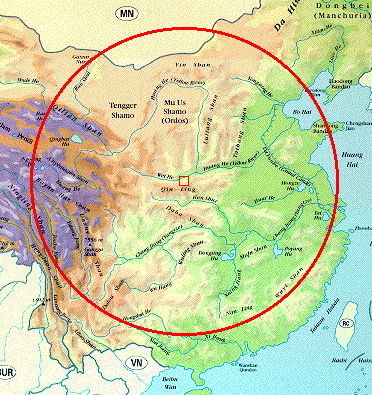
At the end of the Ice Age about 11,600 years ago, many people of the Ice Age Civilization were displaced from the flooded Sunda Shelf and came into China, where they began to compete for food and resources. A few of those people refused to abandon their high culture that was balanced with nature. They isolated themselves from the fierce competition for resources by living in the forests and mountains, and became the Taoists that we know today. Throughout the years, according to Jared Diamond (Guns, Germs, and Steel, W. W. Norton 1997), the Taoists revealed to the general population such techniques as canal lock gates, cast iron, deep drilling, animal harnesses, gunpowder, kites, magnetic compasses, movable type, paper, porcelain, printing, sternpost rudders, wheelbarrows, and more. In China, unlike the Nile River Valley, the transition at the end of the Ice Age was turbulent.
According to an article by Andrew Lawler in Science, 300 (2 May 2003) page 723: "... a team of Chinese and U.S. researchers now proposes that writing in China went through a long, slow evolution that stretches back ... 8000 years ... etched marks found on tortoise shells in a Neolithic grave in Henan Province are the earliest known precursors to what became the system of characters - and they likely were used for shamanic purposes. ... the team led by Xueqin Li ... drew on artifacts from ... Jiahu on the upper reaches of the Huai river between the Yellow and Yangzi rivers. ...[including]... an ancient seven-hole flute made from the bone of a crane ... turquoise ornaments ...[and]... tortoise shells, which in one grave replaced the skull. ... Incised clearly on 14 of the shells were nine signs, with an additional two on bone; most date from 6600 B.C. to 6200 B.C. ... Li's team argues that those marks .. were precursors to later Chinese characters found at the end of the Shang dynasty around 1200 BC. ... In early Mesopotamia about 3200 B.C., scribes began to use tablets and a complex symbol system solely for accounting purposes ... In contrast, the early Shang characters concern only the king's connection to ancestral and magical powers, similar to the earliest New World writing, which is linked to royalty and the sacred calendar. ... Many ofthe Shang characters were found on tortoise shells just like those of Jiahu ... and there is evidence that tortoise shells were used as early as the Neolithic for divination. ...".
To understand China's history since the Ice Age, first look at the land:

The red circle has a radius of about 675 miles, and is centered on Xian. The Northern half of the circle is the drainage basin of the Huang River (Yellow River) and its tributary, the Wei River. Xian is on South side of the the Wei River. The Southern half of the circle is the drainage basin of the Chang River and its tributary, the Han River. Near the Eastern edge of the circle, a canal links the Huang and Chang Rivers. Near the Western edge of the circle, both the Huang and Chang Rivers begin on opposite sides of Yagradagze Shan (5,442 meters high) in the Bayan Har Shan mountains in Qinghai Province. The North Central part of the circle, in the Huang River Valley, is the Loess Plateau of China. It is around 3,300 feet in altitude, and the soil is loess, silt-sized grains of quartz or feldspar cemented loosely by calcium carbonate. By studying the layers of loess soil, you can see how the climate has varied in the past. If the loess grains are deposited on water-saturated ground, they "float around" as they settle and are aligned with the Earth's magnetic field; if the climate is dryer when the loess grains are deposited, they cannot float around and line up with the Earth's magnetic field. Therefore, magnetic-aligned loess indicates a wet climate. This technique shows that the western part of the Chinese Loess Plateau is now arid, but from 9,000 to 6,000 years ago it had 60-100% more rainfall than today. In the eastern part of the Chinese Loess Plateau, rainfall has remained steady for the last 8,000 years These results are consistent with evidence from studies of lake-levels and pollen, and are similar to a 1991 interpretation by An et al. Why did the climate get wetter around 9,000 years ago? At about 11,600 years ago, about when the Vela X supernova was seen in Earth, a very sudden (50 years or so) warming event ended the Ice Age and marked the start of the HOLOCENE AGE of warm climate and glacial retreat. As the glaciers melted, lakes filled up and the climate got wetter. To see how things dried out in the last 6,000 years, look at lake level maps:
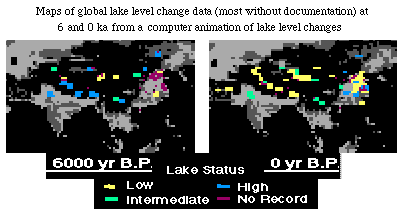
The Huang Loess Plateau is called the "cradle of Chinese civilization". Banpo, near Xian, is a settlement site of 9,000 to 6,000 years ago. It shows a matriarchal society with a communal way of life, each individual grave of a female person being accompanied by three pieces of pottery utensils, without distinction to her status before death. In my opinion, which is not the standard opinion, that society was a good one, consistent with Taoist principles, in which people shared equally the benefits of their well-watered, productive land. One thing that I do not know, but would like to know, is the extent of contact between China and the Sphinx-Giza Civilization of the same time, about 11,600 to 6,000 years ago. One similarity is that China has a Great Pyramid 40 miles southwest of Xian:
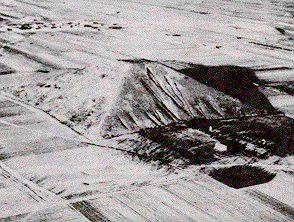
According to Childress (Lost Cities of China..., Adventures Unlimited 1991), China's Great Pyramid is said to be at least 4,000 years old, and likely much older. It is said that its sides were originally painted black on the North, blue-gray (or faded green) on the East, red on the South, white on the West, and yellow on the top Center platform. More Chinese Pyramids exist. Another possible connection is a legendary foundation of Taoism by people from Shen Zhou, or Spirit Ships, which some people say came from a Pacific Ocean "Atlantis", which could have been the Sunda Shelf region that was flooded at the end of the Ice Age, or which may have come from the Nile Lakes homeland of the Sphinx-Giza Civilization. When the climate started to dry up after 6,000 years ago, the society changed. Burial sites of about 4,700 years ago had graves with a central male surrounded by two females, one on each side, resting on their sides facing the male. This was the time of the Yellow Emperor Huang Di, and the beginning of the Chinese calendar. When the drying climate did not continue to support everybody, conflicts began over limited resources. Male warriors who would fight and take things from others became more successful than cooperating females. Population centers began to move to the South and East, where there was more water. The population movements caused more turmoil and problems, similar to the ones encountered by the Sphinx-Giza Civilization at about the same time for much the same reasons. Some wise Taoists remained in the forests and mountains of China, just as some wise people remained in Abyssinia, but they were not typical members of the population. After Huang Di, the Xia dynasty lasted until about 3,600 years ago. Then came the Shang, until about 3,100 years ago, and then the Zhou, Western and Eastern, until about 2,400 years ago. Then there were about 200 years of Warring States:
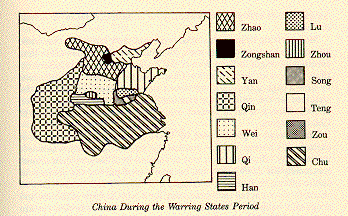
(see China, by Huang, Sharpe 1988)
Qin Shih-huang-di defeated all the other Warring States about 2,200 years ago. He was from the West of China, the son of Luu Buwei (a rich merchant) and a dancing girl (given by Luu Buwei to a Prince of Qin - - the Prince did not know that the dancing girl was pregnant, so he married her). Her son was Qin Shih-huang-di, who succeeded the Prince as King of Qin. To unify China, he applied the Taoist wisdom of the West, given to him by Luu Buwei, who became his counselor during his early years as Emperor. At his death, he left a Terra Cotta Army to guard his pyramid tomb
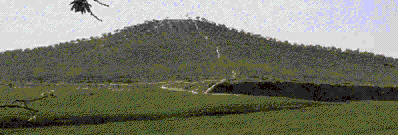
and turmoil among those who would succeed him. Out of the turmoil came the Han dynasty. China remained united, with only brief periods of turmoil, through the advent of Islam about 1400 years ago
(China was the first major world power to recognize Islam, building a mosque in Canton around 630 AD.)
and through invasion by the Mongols about 800 years ago. The Mongols were absorbed into China, and China became the most advanced and powerful country on Earth around 600 years ago. Then, about 1400 AD, China's ships could travel and trade over all the oceans of the Earth. With its technological advantages, China could have ruled the entire Earth from then on, but for a political decision: When Zheng He told the rulers of China of their opportunity to rule the Earth, the rulers were afraid that the new opportunities might disturb their spheres of influence. (When China Ruled the Seas, by Levathes, Simon & Schuster 1994) The rulers prohibited expansion and further technological development. They froze technology and concentrated on maintaining the Huang and Chang River systems, connected by the Grand Canal, thus restricting China substantially to the interior of the red circle:

In doing so, they doomed China to be overtaken and surpassed, sooner or later, by powers from the Outside World. The Outside World had been divided into a lot of Outside Warring States since the fall of the Early Human Civilization almost 6,000 years ago. Spain and Portugal began European world-wide oceanic exploration and colonization around 1500 AD, but they did not combine exploration and colonization with industrialization. When England, Cymru (Wales), and Scotland united around 1707 AD, unifying the Island of Great Britain, the way was open to combine world-wide exploration and colonization with industrialization, because, unlike China in 1400 AD, Britain in the 1700s AD was open to both geographic expansion and technological advancement. As a protected island with ocean trading ports and sufficient population and natural resources, Great Britain initiated the Industrial Revolution and colonized much of the Earth, including parts of China. Now Great Britain's successor as dominant Earth power is its former colony, the United States of America (USA), which was protected by ocean barriers from damage in World War II, about 50 years ago. The same World War II gave the USA the technology of rockets, nuclear power, and electronics necessary to control the entire Earth. The USA now faces a political decision similar to that of China 600 years ago: Should its now-global Earth Civilization continue to advance, or should it protect its profitable (for the USA ruling class) status quo? The only nations that could influence the direction of Earth Civilization independently of the USA might be a resurgent China, or possibly Russia.
......